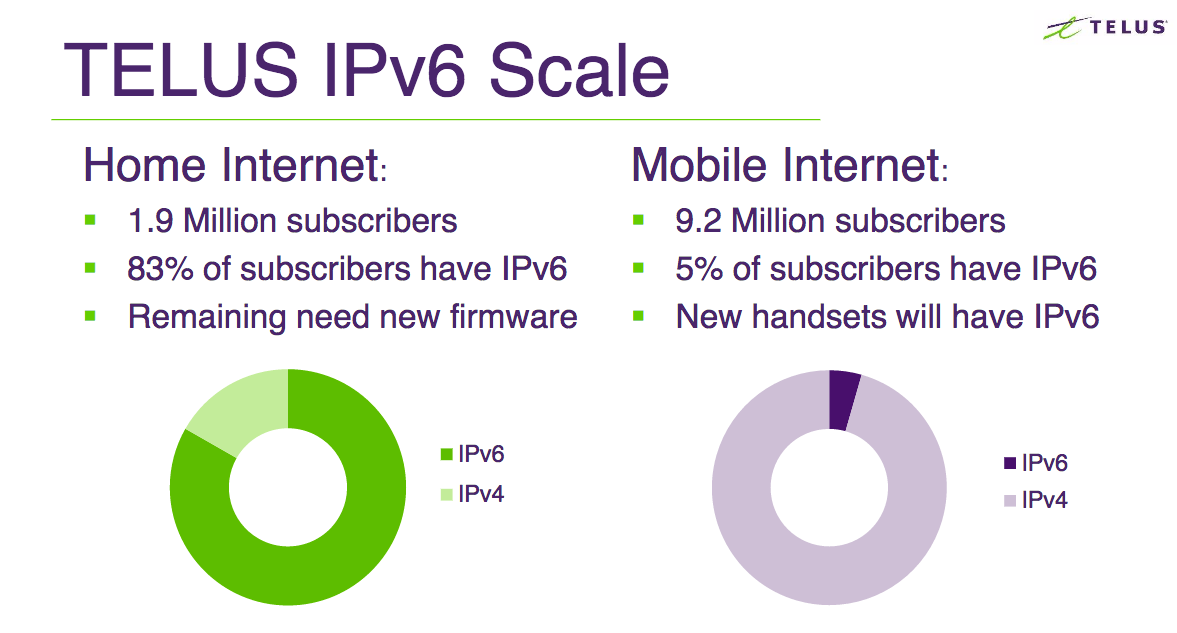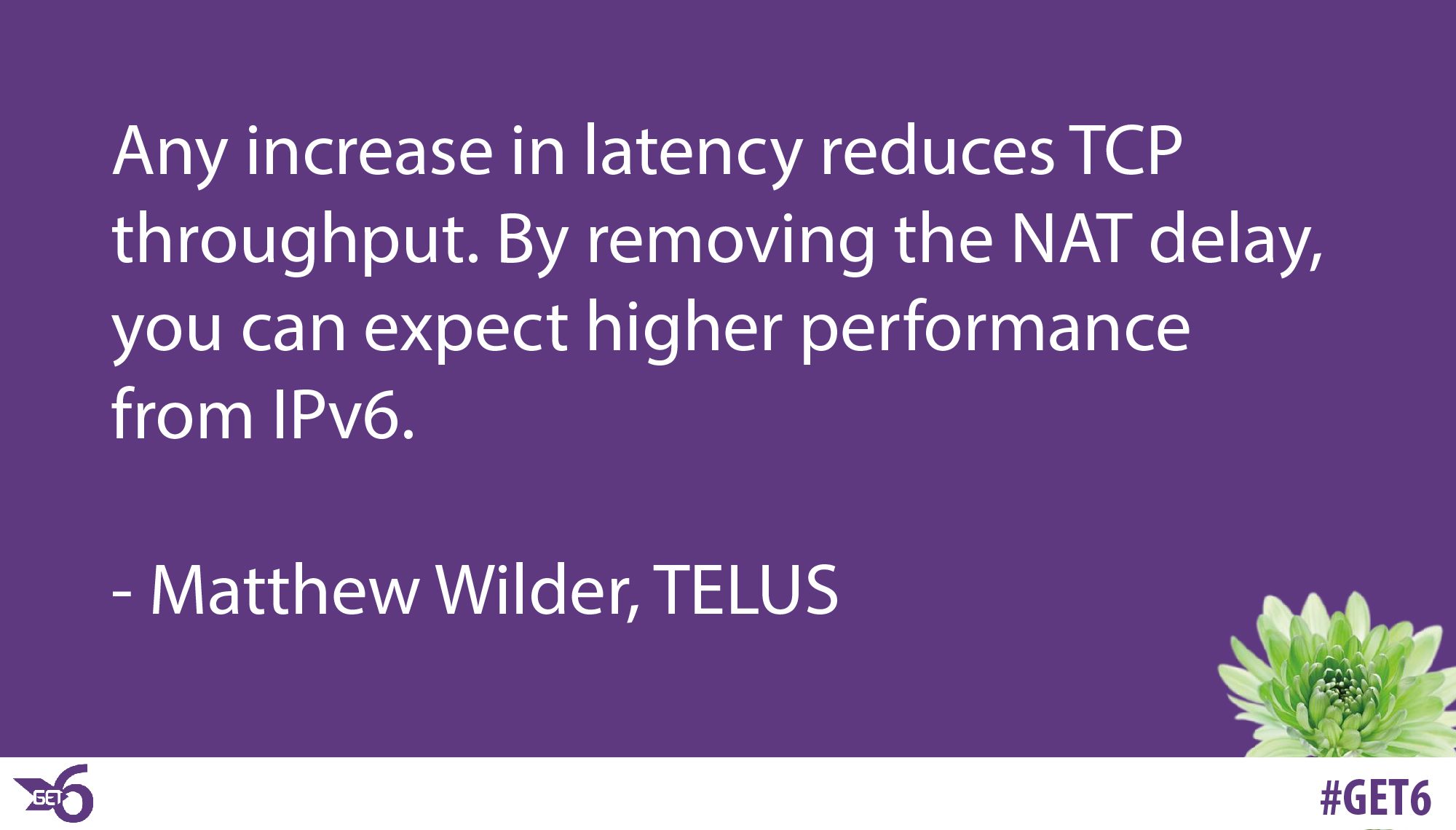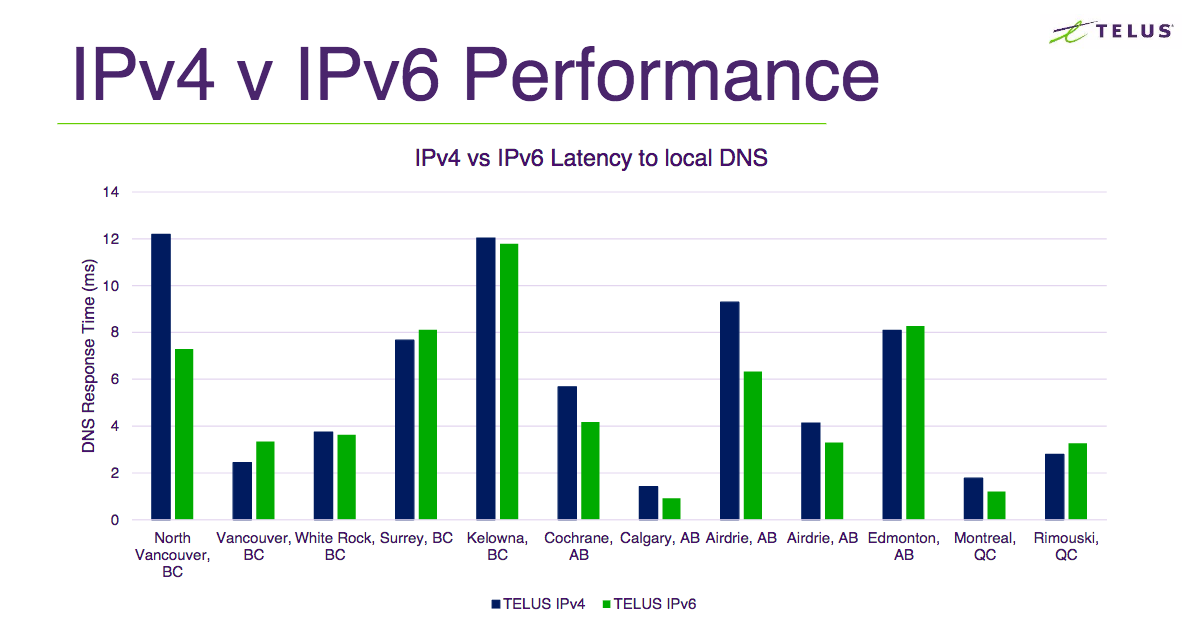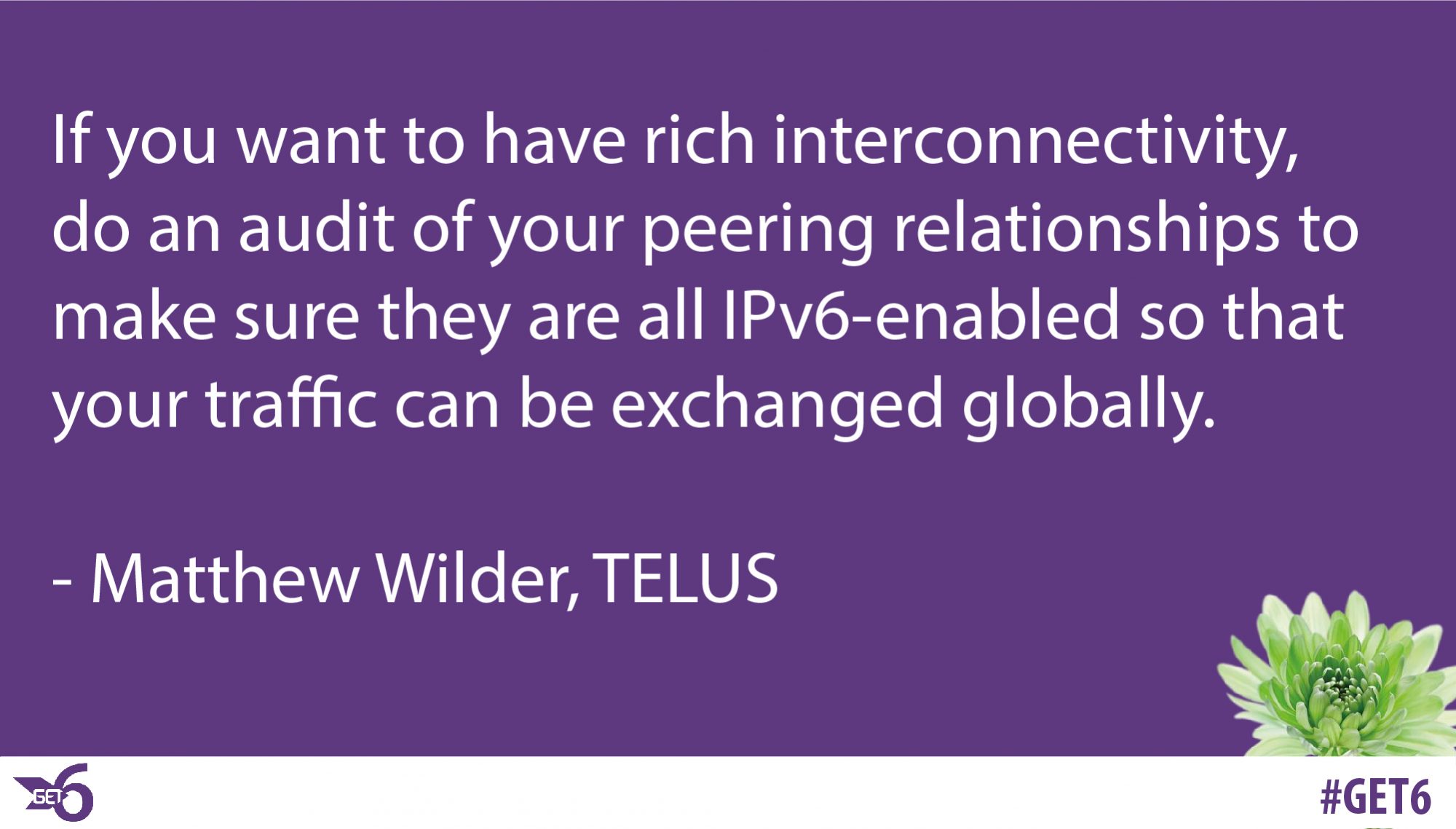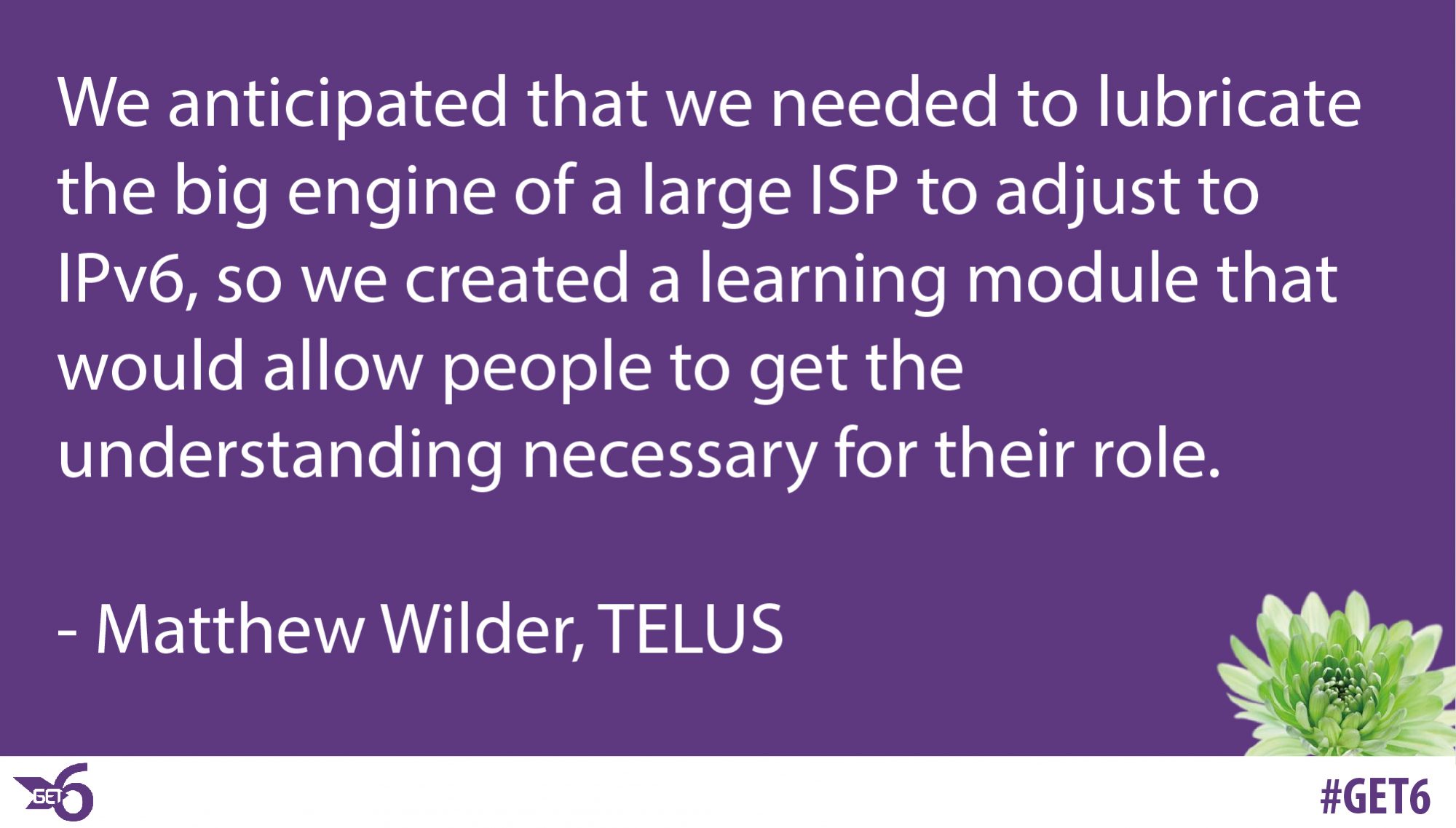
Practical Steps to Accelerate IPv6 Adoption
Telus IPv6 Case Study
TELUS was the first service provider in Canada to deploy IPv6 at scale for the benefit of its customers. As one of the largest telecommunications companies in Canada, TELUS has 1.9 million home Internet subscribers and 9.2 million wireless subscribers. 83% of TELUS Home Internet customers have IPv6 and the other 17% only need a firmware upgrade on their customer premise equipment (CPE). Personally, I have about ten years of experience with IPv6, and I am pleased to be part of a very successful program implementing IPv6 at TELUS. By using TELUS as an example, I will walk you through how service providers or organizations developing their own IPv6 plans can take a few practical steps to accelerate adoption.
Ready for Growth
TELUS implemented IPv6 for two primary reasons. First, to continue to future-proof our systems and, second, to allow for anticipated growth over the coming years. I still have the letter that John Curran sent to organizations in the region in 2009 notifying them of IPv4 depletion as a cool artifact to remember where executive support came from. That letter was received by my CEO, forwarded along to our CIO with notes, then to our CTO and onward. From there, we assembled a program team to determine the big rocks that we needed to get in place, starting with our core network and moving outward. We then factored in our services and created timelines. Much of this planning was driven by knowledge that we were headed to IPv4 scarcity. A key part of our business case was that, at the time, the market was an uncertain element and we didn’t want to be beholden to that market uncertainty. Given today’s IPv4 prices, this was the right decision.
One thing people might not expect is that IPv6 creates a layer of resiliency. If there is a problem with IPv4, whether a content host has an IPv4 outage or there’s BGP hijacking, IPv6 is an alternate path.
There is also a performance gain with IPv6 for both home Internet and mobile. Your home Internet and your CPE/residential gateway will have a network address translation (NAT) function to your private IP. There is a cost of processing time perspective that introduces latency in that path and any increase in latency reduces TCP throughput. By removing the NAT delay, you can expect higher performance from IPv6.
Preparing for IPv6
TELUS has had IPv6 in place for home Internet subscribers since 2015. We have also began rolling out a NAT CGN service to alleviate stress related to the IPv4 scarcity issue. TELUS offers IPv6 for wireless service as well. This is offered on a selective basis, so we are gradually scaling this up. In terms of timing, we prioritized IPv6, and then undertook IPv4 NAT. Our IPv6 project lasted a few years, during which we laid out the capital outlay and people resource capability.
Right off the bat, we asked ourselves - what are the customer end site size subnets that we will allocate for IPv6? We selected a /56 for our home Internet subscribers, a /48 for business end sites and /64 for mobile subscribers. We have a use case for each prefix that helped us to set up the scale of IPv6 allocation needed.
As a national carrier in Canada, we have a broad geography to cover. Part of our efforts to reduce latency involves tying our addresses to the geography. Because we looked at our number requirements, we went back to ARIN to ask for an expansion from our /32 to a /29, and were able to secure that change. We determined how much space was needed per region and broke it down even smaller than by province, so we could optimize routing for our IPv6 blocks. A /32 covers over 64,000 end sites of /48 or 16,000,000 end sites of /56. We then used nibble boundary consistently throughout (hex characters).
Next, we advertised our IPv6 space to our peering and transit partners. If you want to have rich interconnectivity, do an audit of your peering relationships to make sure they are all IPv6-enabled so that your traffic can be exchanged globally. From there, we started rolling out IPv6 at all of our edge nodes across our Multiprotocol Label Switching (MPLS) network. Once the core network routing was functional, we enabled elements like peering and transit. Then, we analyzed the shared infrastructure, like DNS, and completed the service design for each of our standalone services: home Internet, business Internet, fixed services and wireless services.
The Learning Curve
We anticipated that we needed to lubricate the big engine of a large ISP to adjust to IPv6, so we created a learning module that would allow people to get the understanding necessary for their role to manage the changes coming with IPv6. Everyone is used to the IPv4 address format, so wrapping your head around IPv6 was a vital piece to clearing the knowledge base hurdle. We employed both instructor-led training for the core team who would do the engineering and service design, and also multiple e-modules for everyone from our network operations to front line tech support to learn on their own time. For example, those in IT working with BSS, OSS systems need to be aware of IPv6 so they are familiar with the structure and know what to expect.
The other crucial step we took to get ahead of any potential problems was to first perform internal trials in the lab. Then, when we began the production roll out, we started with a friendly trial where employees selected their services and checked to make sure everything was working. We made sure MTUs were not breaking and access to DNS was working. One thing we caught in our friendly trial was that even though we had created the capability for DNS to reply with AAAA records, test sites showed us we had not enabled connectivity to the DNS routes over IPv6 yet. By virtue of our approach of starting with small, internal testing and growing to large production scale, potential risks were reduced as the process progressed.
The implementation of IPv6 was seamless and invisible to the consumer. In fact, the customer contact we did have on IPv6 was only positive. We went back to customers who had posted on our online forums over the years asking when we would move to IPv6 to tell them that it was now available. One of those people we notified even became a friendly tester, so it was cool to include someone who was eager to try it out and get on board.
Practical Steps
Now that I have explained how TELUS deployed IPv6, here is a quick outline of some of the practical steps service providers or organizations can take to accelerate IPv6 adoption:
IPv6 Peering & Transit
-
Rich IPv6 interconnectivity is a must
-
Enable IPv6 on all existing peering links
-
Update your process
-
Enable IPv6 on transit
-
Advertise your IPv6 routes
IPv6 In Your Network
-
Enable your core network
-
Consider 6PE if you run an MPLS network
-
Native IPv6 from the edge out
-
DNS and other shared infrastructure
-
Services can enjoy IPv6 access
Service Design
-
Consider:
-
Network standards
-
Customer premise equipment
-
OSS & BSS systems
-
-
Proof of concept
-
Dev Ops if possible
Start Small & Scale Up
-
Roll out in small increments at first
- Begin with employees, then include friendly customers
-
Identify problems early and improve
-
Prove success at small scale first
-
Ramp up your scale
At TELUS, this process resulted in a successful rollout of IPv6.
My biggest piece of advice would be that if you are have having trouble getting buy-in from decision makers for supporting IPv6 deployment in your organization, look broadly at all sets of benefits you could achieve. Don’t rule anything out. Look for those opportunities where you can see gains for your organization, the benefits you might not have anticipated are there. Imagine what the network would like with IPv6 in it. The sheer scale of IPv6 has far less to do with capacity management that it may initially appear. If you have a large enterprise with a LAN to service employees, you are likely in an ongoing battle with IPv4 as you are constantly scaling and rescaling. Renumbering is difficult, but with an IPv6 single /64, the scale is exceptionally beneficial.
Long term, if everyone moves to IPv6, we can begin to phase out IPv4 and again enjoy the benefits of a single stack. There is a lower technical debt to be borne by all service providers, content providers, businesses and vendors of network equipment. In summary, adopting IPv6 will provide several benefits to your organization, so those that undertake the task of rolling it out, however incrementally, will realize gains for both their organization and their customers.
Any views, positions, statements, or opinions of a guest blog post are those of the author alone and do not represent those of ARIN. ARIN does not guarantee the accuracy, completeness, or validity of any claims or statements, nor shall ARIN be liable for any representations, omissions, or errors contained in a guest blog post.
Recent blogs categorized under: IPv6
GET THE LATEST!
Sign up to receive the latest news about ARIN and the most pressing issues facing the Internet community.
SIGN ME UP →Blog Categories
ARIN Bits • Tips • Updates • Elections • Caribbean • Outreach • Security • RPKI • Public Policy • Guest Post • Grant Program • Fellowship Program • Data Accuracy • IPv6 • Business Case for IPv6 • Internet Governance • Training • IPv4 • Customer Feedback • IRR



